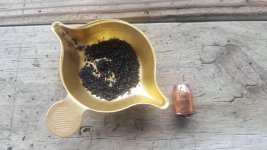Had a squib recently while shooting my Freedom Arms Model 83. The load I was using was a 255 grain X-Treme plated bullet, 22 grains of Alliant 2400 and a CCI 400 primer in a 454 case. This load is about four or five grains over a “Ruger only” 45 Colt load, but about 3 grains under the starting load for 454 Casull in most of the reloading manuals. I’ve used the load for ages, and I’m not aware that 2400 is squib-prone like H110/Win 296.
When I pulled the trigger, I got a “click” instead of a bang, so I held the muzzle downrange for 30 seconds in case it was a hangfire. When I tried to move the cylinder, I found it to be locked up tight. What I first thought was a mechanical problem turned out to be the bullet lodged just inside the barrel locking up the cylinder. I drove the bullet back into the chamber with a brass rod and thus was able to get the cylinder loose. When I pulled the bullet from the defective round, the powder appeared blackened but unburned (see attached pic).
I pulled apart several of the unfired rounds in that batch, but couldn’t find any issues. All charges weighed exactly 22 grains and I found no evidence of any contamination in the case or the powder. All charges were visually inspected prior to bullet seating, and all were at the same level in the case. Since there seemed to be no issues with the load, I proceeded to fire the remaining rounds in the batch with no issues.
I’m puzzled about what happened here. I’m thinking maybe an underpowered primer ignited a few grains of powder near the flash hole which provided enough pressure to push the bullet into the barrel without igniting the entire powder charge. But I’ve never had a weak primer in over thirty years of reloading.
Any ideas?
When I pulled the trigger, I got a “click” instead of a bang, so I held the muzzle downrange for 30 seconds in case it was a hangfire. When I tried to move the cylinder, I found it to be locked up tight. What I first thought was a mechanical problem turned out to be the bullet lodged just inside the barrel locking up the cylinder. I drove the bullet back into the chamber with a brass rod and thus was able to get the cylinder loose. When I pulled the bullet from the defective round, the powder appeared blackened but unburned (see attached pic).
I pulled apart several of the unfired rounds in that batch, but couldn’t find any issues. All charges weighed exactly 22 grains and I found no evidence of any contamination in the case or the powder. All charges were visually inspected prior to bullet seating, and all were at the same level in the case. Since there seemed to be no issues with the load, I proceeded to fire the remaining rounds in the batch with no issues.
I’m puzzled about what happened here. I’m thinking maybe an underpowered primer ignited a few grains of powder near the flash hole which provided enough pressure to push the bullet into the barrel without igniting the entire powder charge. But I’ve never had a weak primer in over thirty years of reloading.
Any ideas?

